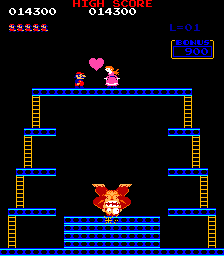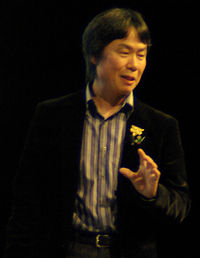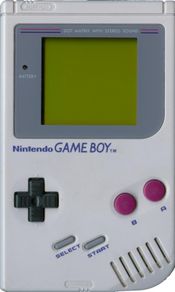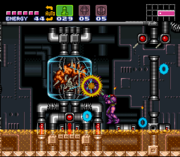Gunpei Yokoi
| Gunpei Yokoi | |
|---|---|
 Gunpei Yokoi |
|
| Born | September 10, 1941 Kyoto, Japan |
| Died | October 4, 1997 (aged 56) |
| Occupation | Game designer |
Gunpei Yokoi, also spelled Gumpei Yokoi (横井 軍平 Yokoi Gunpei) (September 10, 1941–October 4, 1997), was a video game designer in Japan. He was a long-time Nintendo employee, creator of the Game Boy and Game and Watch, and producer of the long-running Metroid series. Yokoi's games have been seen on every Nintendo video game console, with his earliest work appearing on arcade machines. His games have received critical praise from many reviewers, and he has been the recipient of various awards. Yokoi was married. He died in a traffic accident in 1997.
Contents |
Early life
Gunpei Yokoi was born in 1941 and grew up in Kyoto. He graduated from Doshisha University with a degree in electronics. He was first hired by Nintendo in 1965 to maintain the assembly-line machines used to manufacture its Hanafuda cards.[1]
Career

1970-1984
In 1970, Hiroshi Yamauchi, president of Nintendo at the time, came to a hanafuda factory Yokoi was working at and took notice of a toy, an extending arm, which Yokoi made for his own amusement during spare time as the company's janitor and machine maintenance man. Yamauchi ordered Yokoi to develop it as a proper product for the Christmas rush. The Ultra Hand was a huge success, Yokoi also worked on other various Nintendo toys including Ten Billion Barrel puzzle, a miniature remote-controlled vacuum cleaner called the Chiritory, a baseball throwing machine called the Ultra Machine, and a Love Tester. He worked on toys until the company decided to make video games in 1974.[2]

As of the beginning of 1981, Nintendo's efforts to sell in the North American video game market had failed, culminating with the flop Radar Scope in 1980. To keep the company afloat, company president Yamauchi decided to convert unsold Radar Scope games into something new. He approached a young industrial designer named Shigeru Miyamoto, who had been working for Nintendo since 1977, to see if Miyamoto thought he could design an arcade game. Miyamoto said he could.[3] Yamauchi appointed Yokoi to supervise the project.[4] Yamauchi wanted to primarily target the North American market, so he mandated that the game be given an English title. Miyamoto decided to name the game for the ape, whom he felt to be the strongest character.[5] Its sales of $30 a day—or 120 plays—for a week straight, they requested more units.[6] In their Redmond headquarters, a skeleton crew composed of Arakawa, his wife Yoko, James, Judy, Phillips and Stone set about gutting 2,000 surplus Radar Scope machines and converting them with Donkey Kong motherboards and power supplies from Japan.[7] The game officially went on sale in July 1981.[8] By October, Donkey Kong was selling 4,000 units a month, and by late June 1982, Nintendo had sold 60,000 Donkey Kong games overall and earned $180 million.[8] Judy and Stone, who worked on straight commission, became millionaires.[9] Arakawa used Nintendo's profits to buy 27 acres (110,000 m2) of land in Redmond in July 1982.[10] The game made another $100 million in its second year of release.[11] It remained Nintendo's top seller into summer 1983.[12] Donkey Kong also sold steadily in Japan.[13]
Becoming a success, Yokoi continued to work with Miyamoto in various titles including sequels to Donkey Kong, Donkey Kong Jr. and Donkey Kong 3. In his work with Miyamoto he worked on his next title which was based on the character from Donkey Kong. With the character reworked it became Mario, and he was given a brother: Luigi. The game was titled Mario Bros.. Yokoi convinced Miyamoto to give Mario some super human abilities, namely the ability to fall from any height unharmed. Mario's appearance in Donkey Kong - overalls, a hat, and a thick mustache - led Miyamoto to change aspects of the game to make Mario look like a plumber rather than a carpenter.[14] The two-player mode and other aspects of gameplay were partially inspired by an earlier video game entitled Joust.[15] To date, Mario Bros. has been released for more than a dozen platforms.[16]
Yokoi soon created Game & Watch a line of handheld electronic games. Traveling on a bullet train, Yokoi saw a bored businessman playing with an LCD calculator by pressing the buttons. Yokoi then thought of an idea for a watch that doubled as a miniature game machine for killing time.[17]
1985-1990

After Mario Bros, Yokoi worked with Miyamoto on several different games, including Ice Climber and Kid Icarus. He later produced another game titled Metroid. They began work on an action game,[18] which they dubbed "Metroid", named after the game's eponymous creatures, and a portmanteau of the words "metro" and "android" according to Yoshio Sakamoto, the game's director.[19] Metroid was produced by Yokoi. The project was directed by Sakamoto, who previously worked on designs for Donkey Kong Junior, and it featured music written by Hirokazu Tanaka, who also composed for Duck Hunt (1984).[18] Makoto Kanoh was tasked to create the characters and scenarios, and Hiroji Kiyotake designed them.[20] Officially defined as a scrolling shooter video game, and intended to combine Mario's jumping with Link's object-driven ability-enhancing along with the style of science-fiction-inspired action games like Commando (1985) and Contra (1987), Nintendo released Metroid for the Family Computer Disk System on August 6, 1986, and on the Nintendo Entertainment System one year later.[18] The production was described as a "very free working environment" by Tanaka, who stated that, despite being the composer, he also gave input for the game's graphics and helped name the game's areas. Regarding the music, Tanaka said he wanted to make a score that made players feel like they were encountering a "living organism" and had no distinction between music and sound effects. The only time the main Metroid theme is heard is when Mother Brain is defeated, to give the victorious player a catharsis. During the rest of the game, no melodies are present because Tanaka wanted the soundtrack to be the opposite of the upbeat tunes found in other games at that time.[21] Part way through development, one of the developers asked the others, "Hey, wouldn't that be kind of cool if it turned out that this person inside the suit was a woman?", an idea which was incorporated into the game.[22] While Alien (1979) was never mentioned during development, the team is said to have been influenced by the film's atmosphere, and the series has since been one of their biggest inspirations.[23]
He kept producing games such as the Fire Emblem: Ankoku Ryū to Hikari no Tsurugi and others from the Fire Emblem series. He also created ROB and also created the Game Boy which became great successes worldwide. He also headed the development and release of the hugely acclaimed and successful Super Mario Land, a launch title for the Game Boy, that greatly helped boost Game Boy's initial sales. The Game Boy and Game Boy Color combined have sold 118.69 million units worldwide, with 32.47 million units in Japan, 44.06 million in the Americas, and 42.16 million in other regions.[24][25]
1991-1996
Yokoi made a sequel to Metroid, titled Metroid II: Return of Samus. Metroid II marked a "new high point" for handheld game consoles, with graphics that were almost as good as the 8-bit graphics in games for the Nintendo Entertainment System. The game featured a battery backup to allow players to continue their games from a previously saved point.[26] Metroid II was designed by Nintendo R&D1 and produced by Yokoi; they both also worked on the previous Metroid game. Metroid II was released second, but is sixth in the overall story. The game features enhancements from its predecessor that include easier controls which allow Samus to crouch while firing at the same time, and jump while shooting straight down to attack anything below her.[27] Metroid II's designer, Nintendo R&D1, was also involved in developing the Game Boy Color, a device similar to the Game Boy but with a color screen. Nintendo's Dan Owsen acknowledged in an interview that the company planned to release a color version of Metroid II. He believed that Nintendo R&D1 included a special "Metroid palette" in the Game Boy Color's hardware, which "makes Metroid II look really, really nice on Game Boy Color", and remarked that the release should have graphics comparable to the original Metroid on the Nintendo Entertainment System. However, the project was eventually canceled.[28]

Yokoi also produced Super Mario Land 2: Six Golden Coins and Super Mario Land 3: Wario Land. In 1994 Yokoi produced Super Metroid. Development took two years, an extremely long development cycle at the time. When asked why the game took so long to make, Sakamoto responded, "We wanted to wait until a true action game was needed. [...] And also to set the stage for the reappearance of Samus Aran." Super Metroid attempts to stay true to its predecessors. Its music uses 16-bit versions of music from previous games, and previously visited areas reappear. Nintendo Power complimented, "This is great for fans who get an almost seamless transition from the previous games," noting that it also made it easier for the developers of Super Metroid to build the game because they could reuse existing material. Reused areas were modified "to correct parts we were unhappy about in the original game". Previously seen areas were added to Super Metroid to add a sense of familiarity that would satisfy players of previous Metroid games, and "the new sections also give a much greater sense of drama to the game." Sakamoto noted that Super Metroid was deeper and more involved than previous Metroid games, and considered it to have a more dramatic overtone.[29] This would be his last game created. His last work on Nintendo was the Virtual Boy, which was a big failure making Nintendo doubt his abilities. He quit his job soon after. According to David Sheff's book Game Over, Yokoi never actually intended for the console to be released in its present form. However, Nintendo pushed the Virtual Boy to market so that it could focus development resources on the Nintendo 64.[30]
Death
On October 4, 1997, Yokoi was killed in a car accident. After a minor fender-bender, Yokoi and Nintendo associate Etsuo Kiso pulled over on a freeway and exited their car to examine the damage. Two cars struck the vehicle, fatally crushing Yokoi.[31]
Influence and Legacy
Many games produced by Yokoi have received great praise. The Metroid series has been highly praised by critics, being ranked by IGN as the eighth best franchise ever.[32] In 2001, Electronic Gaming Monthly chose Super Metroid as the best game ever.[33] The Metroid games have since appeared in other "best game" lists, with all games released up to 2005 included in a Nintendo Power "Top 200 Nintendo Games list",[34] Prime in the IGN top 100,[35] Metroid, Super Metroid, Prime and Echoes in a list by GameFAQs users;[36] Metroid and Super Metroid in Game Informer's list;[37] and Prime and Super Metroid in Edge's list.[38] The games have also sold very well, with Super Metroid, Metroid Fusion, Metroid Prime, and Metroid Prime 3: Corruption exceeding one million copies sold.[39][40][41] Mother Brain has been commonly ranked among the all-time best video game bosses.[42] IGN praised the well timed music that helped add suspense to the experience.[43] GameSpot described Super Metroid as better than the original "in literally every conceivable way",[44] Metroid Fusion was noted for its "understated score" which fit the mood of the adventure and its excellent stereo sound effects, making it an uncommonly good Game Boy Advance sound experience.[45] Other games like Kid Icarus also got praised. It was awarded the 84th slot in IGN's 2003 list of the Top 100 Games of All Time[46] and was also inducted into the GameSpy Hall of Fame.[47] Also from IGN, it was ranked 20th in IGN's Top 100 NES Games.[48] GameTrailers placed Yokoi on their lists for the "Top Ten Game Creators".[49]
Yokoi created many inventions which have served for inspiration for many game designers over the years. Metroid had an impact and has influenced in game series like Konami's Castlevania, which started with Castlevania: Symphony of the Night, which had similar gameplay to Super Metroid,[50] for which the game has been referenced as "Castleroid" and "Metroidvania" (portmanteaux of Castlevania and Metroid).[51] He also updated the idea of the D-pad.
References
- ↑ "Forgotten Giant: The Brilliant Life and Tragic Death of Gunpei Yokoi". Game Informer 12 (105): 116. January 2002.
- ↑ Fleming, Dan (1996). Powerplay. Manchester University Press ND. p. 180. ISBN 978-0-7190-4717-6.
- ↑ Kent 157.
- ↑ Kent 158.
- ↑ Kohler 39
- ↑ Sellers 68.
- ↑ Sheff 110.
- ↑ 8.0 8.1 Kent 211.
- ↑ Kent 160
- ↑ Sheff 113.
- ↑ Sheff 111.
- ↑ Kent 284.
- ↑ Kohler 46.
- ↑ "IGN Presents The History of Super Mario Bros.". IGN.com. 2007-11-08. http://games.ign.com/articles/833/833615p1.html. Retrieved 2008-09-26.
- ↑ Fox, Matt (2006). The Video Games Guide. Boxtree Ltd. pp. 261–262. ISBN 0752226258.
- ↑ Eric Marcarelli. "Every Mario Game". Toad's Castle. http://toadscastle.net/list-games.html. Retrieved 2008-10-01.
- ↑ The Escapist: Searching for Gunpei Yokoi
- ↑ 18.0 18.1 18.2 "The Metroid Retrospective – Part 1". GameTrailers. 2007-07-25. http://www.gametrailers.com/player/22771.html. Retrieved 2009-02-20.
- ↑ "Episode 10". GameMaster CX. Fuji TV. 2003.
- ↑ McLaughlin, Rus (2008-08-15). "IGN Presents The History of Metroid". IGN. http://retro.ign.com/articles/815/815011p1.html. Retrieved 2009-02-23.
- ↑ Brandon, Alex (2002-09-25). "Shooting from the Hip: An Interview with Hip Tanaka". Gamasutra. http://www.gamasutra.com/features/20020925/brandon_01.htm. Retrieved 2008-02-19.
- ↑ "Metroid: Zero Mission director roundtable". IGN. 2004-01-30. http://gameboy.ign.com/articles/488/488084p3.html. Retrieved 2008-02-20.
- ↑ Robinson, Andy. "The History of Metroid – Part One". Computer and Video Games. http://www.computerandvideogames.com/article.php?id=173735. Retrieved 2008-09-30.
- ↑ "Consolidated Sales Transition by Region" (PDF). Nintendo. 2010-01-27. http://www.nintendo.co.jp/ir/library/historical_data/pdf/consolidated_sales_e0912.pdf. Retrieved 2010-02-14.
- ↑ "A Brief History of Game Console Warfare: Game Boy". BusinessWeek. McGraw-Hill. http://images.businessweek.com/ss/06/10/game_consoles/source/7.htm. Retrieved 2008-07-30. "Game Boy and Game Boy Color's combined lifetime sales reached 118.7 million worldwide, according to Nintendo's latest annual report."
- ↑ Kent, Steven L. (1994-05-05). "Inside Moves". The Seattle Times. http://community.seattletimes.nwsource.com/archive/?date=19940505&slug=1908869. Retrieved 2009-02-19.
- ↑ "The Metroid Retrospective – Part 1". GameTrailers. 2007-07-25. http://www.gametrailers.com/player/22771.html. Retrieved 2009-02-19.
- ↑ "The MDb Interviews Dan Owsen". 1998. http://www.metroid-database.com/index.php?g=features&p=owsen. Retrieved 2009-02-21.
- ↑ "Everything you always wanted to know about Samus". Game Players 7 (5): 18–20. May 1994.
- ↑ Game Over: How Nintendo Zapped an American Industry, Captured Your Dollars, and Enslaved Your Children by David Sheff, 1993, Random House.
- ↑ http://stars.ign.com/objects/919/919302_biography.html
- ↑ "The Top 25 Videogame Franchises". IGN. 2006-12-04. http://ps3.ign.com/articles/749/749069p4.html. Retrieved 2008-02-20.
- ↑ EGM staff (2001). "Electronic Gaming Monthly's 100 Best Games of All Time". Electronic Gaming Monthly. http://web.archive.org/web/20030611191341/http%3A//gamers.com/feature/egmtop100/index.jsp. Retrieved 2006-11-17.
- ↑ "NP Top 200". Nintendo Power 200: pp. 58–66. February 2006.
- ↑ "IGN Top 100 Games 2007 | 30: Metroid Prime". IGN. http://top100.ign.com/2007/ign_top_game_30.html. Retrieved 2008-02-20.
- ↑ "Fall 2005: 10-Year Anniversary Contest – The 10 Best Games Ever". GameFAQs. http://www.gamefaqs.com/features/contest/top10. Retrieved 2008-02-20.
- ↑ "Top 100 Games of All Time". Game Informer 100: 34. August 2001.
- ↑ "Edge's Top 100 games". Edge. http://www.next-gen.biz/index.php?option=com_content&task=view&id=6231&Itemid=2&limit=1&limitstart=9. Retrieved 2008-02-20.
- ↑ "US Platinum Videogame Chart". The Magic Box. 2007-12-27. http://www.the-magicbox.com/Chart-USPlatinum.shtml. Retrieved 2008-03-19.
- ↑ "Super Metroid". N-Sider. 2007-01-01. http://www.n-sider.com/gameview.php?gameid=112&view=dev. Retrieved 2008-03-19.
- ↑ "Financial Results Briefing for the Nine-Month Period Ending December 2007". Nintendo. 2008-01-25. pp. 6. http://www.nintendo.co.jp/ir/pdf/2008/080125e.pdf#page=6. Retrieved 2008-01-25.
- ↑ Ryan Stewart and Mitch Krpata (October 13, 2006). "The 20 Greatest Bosses in Video Game History - #4: Mother Brain". The Phoenix. http://thephoenix.com/article_ektid24907.aspx. Retrieved 2008-02-26.
- ↑ Tim Jones (1999-06-14). "Metroid 2: Return of Samus". IGN. http://gameboy.ign.com/articles/159/159335p1.html. Retrieved 2008-02-19.
- ↑ Provo, Frank (2007-08-27). "Super Metroid review". GameSpot. http://www.gamespot.com/wii/action/supermetroid/review.html. Retrieved 2008-02-20.
- ↑ IGN Staff (2002-11-12). "Metroid Fusion". IGN. http://gameboy.ign.com/articles/377/377060p2.html. Retrieved 2008-03-19.
- ↑ "IGN's Top 100 Games of All Time (81–90)". IGN. 29 April 2003. Retrieved 24 May 2006.
- ↑ Cassidy, William. "Like its mythological namesake, Kid Icarus's time in the sun was entirely too brief". GameSpy. 14 September 2003. Retrieved 24 May 2006.
- ↑ "IGN's Top 100 NES Games". IGN. Retrieved 14 February 2010.
- ↑ "Top Ten Game Creators". Gametrailers.com. http://www.gametrailers.com/player/44356.html. Retrieved 2010-02-28.
- ↑ "GameSpot Greatest Games of All Time: Castlevania: Symphony of the Night". GameSpot.com. http://www.gamespot.com/gamespot/features/all/greatestgames/p-3.html. Retrieved 2007-06-13.
- ↑ "Super Castlevania IV Wii Virtual Console Review". IGN.com. http://wii.ign.com/articles/754/754967p1.html. Retrieved 2007-06-13.